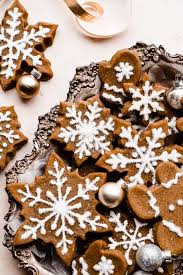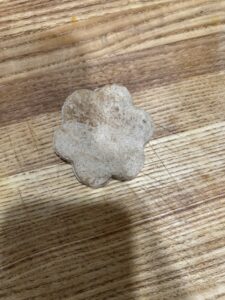
Of the many possible alterations to the gingerbread cookie recipe, I focused on the effects of baking powder vs. baking soda, the impact of a decreased baking temperature, and the consequences of removing molasses from the recipe. Before breaking down the effects of the various alterations, we will first look at the impact each ingredient in the original recipe contributes to the final product of gingerbread cookie!
Each ingredient in the original recipe of gingerbread cookies impacts the final product of the cookies. The recipe for gingerbread cookies only uses two wet ingredients in the entirety of the thirteen ingredients listed. One of the wet ingredients is molasses, a thick syrup made from the juice byproduct during the processing of cane sugar. The different forms of molasses are created due to increasing amounts of caramelization. Molasses both contributes flavor to the cookies and acts as the acid presence needed in order for the baking soda reaction to occur. The other wet ingredient is vanilla extract, an alcohol with artificial or imitated vanilla flavoring, used to incorporate the taste of vanilla in the recipe.
In the lengthy list of dry ingredients, the first ingredient is brown sugar. Brown sugar is made by coating sucrose crystals with a layer of molasses. Because brown sugar is soft and clingy, it is hydroscopic, meaning it attracts water. Brown sugar also facilitates the Maillard Browning reaction, which occurs between a reducing sugar and an amino acid, because the reaction requires a high sugar content. The addition of spices in the recipe, such as orange zest, ground ginger, ground cinnamon, ground coriander, ground cloves, and ground nutmeg, provides the characteristic spice associated with gingerbread cookies. Most of the experience of taste occurs because of the odor receptors in the nose, while the other part derives from the taste buds of the mouth. Because the recipe calls for each of the spices to be ground, each spice has already been broken apart so the particles are exposed, which produces the strong smell associated with many of the spices. Salt and pepper additionally add flavor. One of the most important ingredients in the recipe is baking soda. Baking soda acts as a leavening agent, enabling the cookies to rise. Baking soda also increases the Maillard Browning reaction, because the reaction requires a high pH and baking soda is extremely basic. The last ingredient, all-purpose flour, adds the basis for gluten formation in the cookies. The recipe calls for all-purpose flour which contains 10-11% gluten forming proteins, meaning the cookies will have a moderate gluten presence but will not have the consistency of bread or of cake, which use their own respective flours.
One of the potential changes to the original recipe that affects the Maillard Browning recipe would be to lower the temperature at which the cookies are baked. The Maillard Browning reaction, which provides the color and contributes to the flavoring of the cookies, can be increased with higher temperatures, which is why the recipe calls for the temperature to be set to 350 degrees Fahrenheit. In lowering the temperature, one could test whether the reaction continued to occur or not. Another possible alteration includes excluding the molasses as a way understand the impact of molasses on the cookies. Despite removing the additional ingredient of molasses, the recipe will continue to have a slight molasses presence provided by the molasses coated sucrose of the brown sugar. Removing the molasses would consequently remove the additional flavor provided. In addition, the cookies would not be as dark in color without the molasses because the molasses acts as an acid for the Maillard Browning reaction to occur which contributes to the color of the cookies, so without the acid, the Maillard Browning reaction would be less pronounced. One more alteration to the recipe that would affect both the leavening and the occurrence of the Maillard Browning reaction would be to exchange the baking soda that is called for with baking powder. Baking soda is a pure compound, while baking powder is made by combining baking soda with an acid such as cream of tartar. While baking soda undergoes only one round of CO2 gas release, baking powder undergoes two rounds of CO2 gas release. With baking powder, the first gas release occurs when the powder comes into contact with water and again when the product bakes, but the only gas release in baking soda occurs when the soda comes into contact with an acid. Replacing the baking soda with baking powder would produce an increase in the leavening of the baked good.
The photo on the left shows the gingerbread cookie I made with a few of the alterations described above. This recipe did not include molasses, used baking powder instead of baking soda, and was baked at a lower temperature than was called for. Because of the alterations, the cookie was much more pliable than it should be and it had a texture similar to the texture of Play Dough. The cookie also did not undergo the Maillard Browning reaction.


Ingredients
-
Wet Ingredients
- Dry Ingredients
Instructions
- Pre-baking: Pre-heat oven to 350 degrees Fahrenheit.
- First: In an electric mixer combine the butter, brown sugar, molasses, vanilla extract, orange zest, ground ginger, ground cinnamon, salt, baking soda, ground cloves, ground coriander, ground nutmeg, and pepper. Start mixer on low, then move speed to medium and combine for five minutes.
- Second: Add all the flour to the bowl, then separate the dough into two sections and refrigerate for two hours.
- Third: Roll refrigerated dough with rolling pin until dough is 1/8 in in thickness. Coat table surface and rolling pin with flour to prevent the dough from sticking.
- Fourth: Use cookie cutters to cut dough into desired cookie shapes and place on a baking tray lined with parchment paper.
- Fifth: Place tray in oven and bake cookies for twelve minutes.
Notes
Bibliography: https://www.seriouseats.com/what-is-the-difference-between-baking-powder-and-baking-soda-in-pancakes (accessed April 11, 2023). Potter, Jeff. Cooking for Geeks: Real Science, Great Cookies, and Good Food, 2nd ed.; O’Reilly Media, Inc., 2016. Parks, Stella. Cookie Science: The Real Differences Between White and Brown Sugars. https://www.seriouseats.com/faq-difference-brown-white-granulated-sugar-baking-cookies (accessed April 11, 2023). Parks, Stella. Gingerbread Cookies Recipe. https://www.seriouseats.com/gingerbread-cookies (accessed April 11, 2023). Parks, Stella. How Does Baking Powder Affect My Cookies? https://www.seriouseats.com/cookie-science-baking-powder (accessed April 11, 2023). Parks, Stella. How Baking Soda Works. https://www.seriouseats.com/cookie-science-how-baking-soda-works#:~:text=Italsoraisesthedough's,spreadbeforethe eggsset (accessed April 11, 2023).